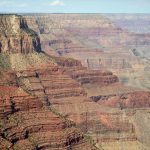
500-million-year-old Grand Canyon rock layer finally gets a name

A 500-million-year-old grand canyon rock layer – has finally been given the name Frenchman Mountain Dolostone by US geologists
UNLV geologists named the ancient rock layer after a Las Vegas mountain that contains similar strata.
The Grand Canyon is one of the seven wonders of the world, visited by millions of admirers each year. So, naturally, you’d think that all of its rock layers had been studied and named. But you’d be wrong.
In a new report, a University of Las Vegas, Nevada-led research team outlined how it identified and bestowed a moniker upon a previously unexplored 500-million-year-old Grand Canyon formation: the Frenchman Mountain Dolostone.
The newly named rock layer has lain hidden in plain sight throughout the Grand Canyon for millennia, but – until now – geologists had neither named it nor studied it in detail.
The UNLV research team named it the Frenchman Mountain Dolostone (FMD) – after a similarly named mountain that lies adjacent to Las Vegas. That’s where the FMD is thickest, most complete, and most accessible for study.
Through scientific detective work, the researchers were able to narrow down the age of this stratigraphic interval and its relationship to strata in the Grand Canyon.
Lead author Steve Rowland, an emeritus professor of geology at UNLV and palaeontologist at the Las Vegas Natural History Museum, said: “For decades, geologists were unable to precisely correlate the succession of strata at Frenchman Mountain with those in the Grand Canyon, in part because Frenchman Mountain was tectonically displaced about 40 miles to the west since the rocks were deposited.
“Establishing detailed descriptions and thickness measurements of the strata at Frenchman Mountain and also in the Grand Canyon has finally allowed us to solve this problem.”

Precisely dated rock layers
The FMD is over 1,200 feet thick at Frenchman Mountain, Rowland said, but it thins dramatically toward the east. The portions exposed within the Grand Canyon range in thickness from nearly 400 feet near the ‘West Rim’ Skywalk to less than 100 feet in Marble Canyon, in the eastern part of Grand Canyon National Park.
In 1945, geologist Edwin McKee distinguished – but did not formally name – the cliff-forming interval of rocks that occur just above the well-known Muav Formation. The FMD contains no fossils, so McKee was unsure of its age.
Rowland’s team used a relatively new technique to determine the FMD’s age – subtle differences in the ratio of stable isotopes of carbon.
Fluctuations in the ratios of these isotopes occurred at the same time all over the Earth as the layers were deposited.
The researchers compared fluctuations in the Frenchman Mountain strata with those identified in precisely dated rock layers elsewhere in the world.
The results indicate that the newly named formation was deposited over an interval of 7.3 million years, during the Cambrian Period, between 502.8 million and 495.5 million years ago.
The FMD is the first new formation to be named in the canyon since 1985 when the Surprise Canyon Formation was named.
It is also the first rock layer exposed in the Grand Canyon to be named for a location outside the Grand Canyon region.
The research published in Geosphere.
Image 1: View of the Grand Canyon from the South Rim. © Josh Hawkins/ UNLV.
Image 2: Quartermaster Canyon (Arizona) exposure, with stratigraphic units labelled. Frenchman Mountain Dolostone here is 117m thick. © Stephen Rowland/ UNLV.














